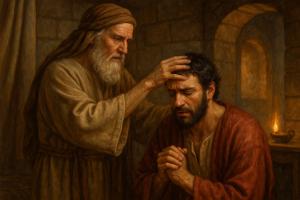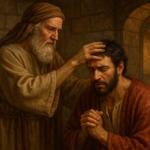What can we know about Ananias, a minor character from the book of Acts? If any person could claim to have played a major role in saving Paul the Apostle, it would be this guy. Unfortunately, we find him mentioned nowhere in Scripture except in Acts. What can we learn from him?
When Paul Met Ananias
The two passages in Acts that speak of Ananias include the first narrative about Paul’s Damascus experience (Acts 9) and Paul’s first speech about that experience (Acts 22). Let’s look at these passages more carefully.

Acts 9:1-19
“Saul,” a.k.a. Paul, intends to persecute Christ’s followers. On the road to Damascus, he has a blinding encounter with the Lord Jesus, who tells him to go to Damascus for further instruction. He is then led by travel companions, and for three days he is blind in Damascus. He neither eats nor drinks anything, although it is clear from the text that he prays during that time (Acts 9:1-9).
Meanwhile, the Lord appears in a vision to Ananias telling him to seek out Saul on a particular street called “Straight.” Saul is staying in the home of a man named Judas. The Lord tells Ananias that Saul is praying and sees in his own vision that a man named Ananias will lay hands. This is how Saul will recover his sight (9:10-12).
Ananias protests to the Lord that Saul persecuted the saints in Jerusalem and comes to Damascus to do the same thing. The Lord responds for Ananias to “Go, because this one [Paul] is a chosen vessel to me to bear my name before nations (gentiles) and before both kings and sons of Israel. For I will show him how much he must suffer for my name’s sake” (9:13-16).
Ananias then sets off to find Paul. When he enters into the house, he places his hands on Saul and says, “Brother Saul, the Lord sent me, Jesus who appeared to you in the way which you were coming, so that you might receive sight and be filled with the Holy Spirit.” Immediately, something like scales fall from his eyes, and he receives his sight. And after rising, he is baptized. Also, he takes some food and recovers his strength (9:17-19).
Acts 22:11-16
In this text Paul is sharing his testimony about his calling.
He says that after he came to Damascus blind, Ananias, “a devout Jew in Damascus, spoken of favorably by other Jews in the area,” comes to Saul. Ananias standing before Saul said, “Brother Saul, receive your sight!” Saul in that same hour receives his sight (Acts 22:11-13).
Ananias says, “The God of our fathers has appointed you to know his will and to see the Righteous One and hear his voice from his mouth, because you will be a witness for him to all peoples of what you have seen and heard” (22:14-15).
He continues, “And now why delay? Arising, be baptized and wash away your sins, calling on his name!” (22:16).
Reflection on the Two Passages
In both versions of the encounter, Ananias addresses Paul and heals him. The first version takes us behind the scene to Ananias’s vision. We probably know about this private encounter because Ananias either told Paul of it, or he told others who eventually relayed the information to Luke, perhaps orally.
What can we learn from this? What stands out is Ananias’s obedience to the Lord’s command. He probably felt anger towards Saul, and perhaps unforgiveness towards him for persecuting the saints. He also may have feared meeting someone as violent as Saul. Even so, he considers it more important to follow the Lord’s leading than follow his own emotions.
Ananias: A Deux ex Machina?
It will hardly do to suggest that Luke invented the person of Ananias. This character is not a deus ex machina.* The author’s sources for Luke-Acts appear to come from ministers and eyewitnesses (Luke 1:1–4; cf. Acts 1:1–3). This makes a fabrication of this sort unlikely. Ananias also appears in two distinct genres—a narrative (Acts 9) and a speech (Acts 22).
The narrative includes that Ananias meets Saul in a home owned by a person named Judas (Acts 9:11). The location of this home is in Damascus on a street called Straight (Εὐθεῖα). This street survives to this very day as the east to west street called, Derb el-Mustaqim. We also know it as Souq Midhat Pasha in reference to its market.**
The street name in the narrative seems to serve no purpose except as a historical marker for the meeting. Perhaps Judas’s own name is remembered here because of his recollection of the meeting that was passed on to Luke as another source independent of Paul. (And no, this is not Judas Iscariot the traitor! Judas is a very common name among first-century Jews.) Along with Ananias, this person probably became a Christ-follower.***
We hear from Paul that Ananias is a devout man with regard to the Law, and well-regarded among local Jews. Ananias’s Torah adherence at first sight sits awkwardly with Paul’s circumcision-free gospel in his letters. However, Ananias’s loyalty to the Torah serves well in this context. Paul is under arrest and denying trumped-up charges against him in Jerusalem that he violated the Law.
Why Is Ananias Never Mentioned in Paul’s Letters?
Ananias receives no mention in any of Paul’s letters. Then again, Paul never discusses his Damascus experience in the detail that we find in Acts. Galatians 1:11–17 is the most thorough recollection of this sort, and here he mentions Damascus only in passing. But even in Acts he fails to mention Ananias when giving his testimony before Herod Agrippa II (Acts 26). Apparently, it was not expedient for him to mention Ananias every time he gave his testimony.
This would especially be true in Galatians. In this letter, Paul is insisting that his gospel did not come from a human source (Gal 1:11–17). Hence, to add Ananias to his testimony here would be rhetorically counterproductive!
Nevertheless, even in Acts, the Lord reveals to Paul that more instruction is ahead in Damascus (Acts 9:6; 22:10). And when praying, he sees in a vision that he would meet Ananias (Acts 9:11–12). The Lord in a separate vision also reveals Paul’s calling to Ananias and sends him to heal Paul (9:10, 15–16; 22:13–16).
This all suggests that Ananias’s role is instrumental only. Paul’s calling indeed comes from divine revelation rather than humanly authorized. This is confirmed again when the Lord reiterates and specifies Paul’s calling in another vision (Acts 22:17–21).
Ananias’s Role in Paul’s Baptism and Calling
When Ananias meets Paul, he calls him “brother Saul.” This makes him a fellow Jew, especially when coupled with “the God of our fathers.” Ananias lays hands on him, and Paul is able to see again.
Paul’s blindness lasts for three days, the same amount of time Jesus spent in the grave. Ananias also tells Paul to “rise up,” a nod to resurrection. Paul then gets baptized and is filled with the Spirit. He is given new life.
Paul speaks of this experience in a roundabout way in his letters. He claims to have experienced both Spirit- and water baptism by the use of the first-person plural “we.” “In one Spirit we were all baptized into one body…” (1 Corinthians 12:13). “Do you not know that those of us who were baptized into Christ Jesus were baptized into his death?” (Romans 6:4). To have the Spirit is to be saved (Rom 8:9; 1 Cor 12:3 cf. Rom 10:9–13).
During this meeting, Ananias likewise discloses Paul’s calling to be a witness for the gospel. He will be a witness to all peoples, Jews and gentiles. Later on in a separate vision in Jerusalem about three years after his Damascus experience, the Lord calls Paul to target gentile nations (Acts 22:17–21). His calling to the nations is later confirmed by the apostles in Galatians 2:7–9.
Lesson to Be Learned
Although Ananias plays only a minor role in the Bible, it is a big minor role! This man becomes the instrument through whom Paul gets saved and receives his calling. Untold multitudes of people, especially the non-Jews, get saved through his message. He also becomes the foremost writer of the New Testament.
We can learn from Ananias’s example that obedience to the Lord brings about great things. And sometimes the most unlikely people we share our faith with, and influence, can turn out to be greatly used by God. Forget Ananias? No way!
Notes
* Namely, “god in the machine.” This is a literary devise in which a hero or higher power is invented and inserted into the storyline to save the day (or in this case, to save Paul!).
** See “Love Damascus.” On the street, see further Craig Keener, Acts (Baker Academic) 2:1652–53.
*** On named minor characters in Luke and the other Gospels as people who may have joined early Christ communities, see Richard Bauckham, Jesus and the Eyewitnesses, 2nd ed. (Eerdmans), 39–92.













